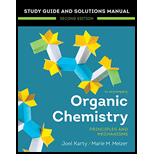
Concept explainers
(a)
Interpretation:
The specific relationship between the pair of molecules shown is to be determined.
Concept introduction:
The intersection of a horizontal and vertical line indicates a carbon atom- typically an asymmetric carbon. The atom at the intersection is a carbon atom. The substituents on the vertical bonds point away from the observer while those on the horizontal bonds point toward the observer.
To determine the R/S configuration at the asymmetric carbon (chiral center), the vertical bonds are replaced by dash bonds and horizontal ones by wedge bonds. The groups on these bonds are then assigned priorities according to Cahn-Ingold-Prelog rules. If the priority groups 1 to 3 are arranged clockwise with the lowest priority group pointing away (at the back), the configuration of the asymmetric carbon is R. If they are arranged counterclockwise, the configuration is S.
If the lowest priority group is pointing toward the observer (it is in the front), then the actual configuration is reverse of that indicated. That means if the arrangement is clockwise, the actual configuration is S, and if counterclockwise, it is R.
If the molecules have different formulas, they are unrelated compounds. If the formulas are same, but the connectivity of atoms is different, the molecules are constitutional isomers.
If the formulas as well as connectivities are the same, then the molecules may be the same or stereoisomers.
The configuration of each asymmetric carbon is then compared to determine the specific relationship between the two molecules. If the configurations are the same, the molecules may be the same or conformers of the same molecule. Conformers are molecules that can be interconverted by a rotation about a single bond.
If the configurations at a single chiral center are different, then the two molecules are enantiomers.
If the molecule contains more than one chiral center, then a difference in the configuration of all chiral centers makes them enantiomers. If the configurations are different at some but not all the chiral centers, then the molecules are diastereomers.
Answer to Problem 5.73P
The molecules are the same.
Explanation of Solution
The Fischer projections are

After converting the Fischer projections to dash-wedge representation, it can be shown that the two are the same.
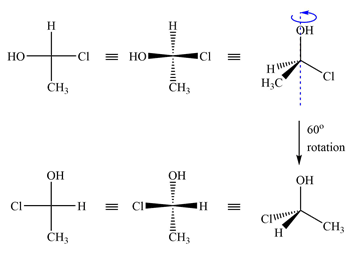
Rotating the first molecule through
Therefore, the two molecules are the same.
The two molecules are identical because rotating the dash-wedge structures interconverts them into each other.
(b)
Interpretation:
The specific relationship between the pair of molecules shown is to be determined.
Concept introduction:
The intersection of a horizontal and vertical line indicates a carbon atom- typically an asymmetric carbon. The atom at the intersection is a carbon atom. The substituents on the vertical bonds point away from the observer while those on the horizontal bonds point toward the observer.
To determine the R/S configuration at the asymmetric carbon (chiral center), the vertical bonds are replaced by dash bonds and horizontal ones by wedge bonds. The groups on these bonds are then assigned priorities according to Cahn-Ingold-Prelog rules. If the priority groups 1 to 3 are arranged clockwise with the lowest priority group pointing away (at the back), the configuration of the asymmetric carbon is R. If they are arranged counterclockwise, the configuration is S.
If the lowest priority group is pointing toward the observer (it is in the front), then the actual configuration is reverse of that indicated. That means if the arrangement is clockwise, the actual configuration is S, and if counterclockwise, it is R.
If the molecules have different formulas, they are unrelated compounds. If the formulas are same, but the connectivity of atoms is different, the molecules are constitutional isomers. If the formulas as well as connectivities are the same, then the molecules may be the same or stereoisomers.
The configuration of each asymmetric carbon is then compared to determine the specific relationship between the two molecules. If the configurations are the same, the molecules may be the same or conformers of the same molecule. Conformers are molecules that can be interconverted by a rotation about a single bond.
If the configurations at a single chiral center are different, then the two molecules are enantiomers.
If the molecule contains more than one chiral center, then a difference in the configuration of all chiral centers makes them enantiomers. If the configurations are different at some but not all the chiral centers, then the molecules are diastereomers.
Answer to Problem 5.73P
The two molecules are the same.
Explanation of Solution
The Fischer projections are

The first projection is converted into the second one by a simple rotation through
Rotating a Fischer projection in the plane of the paper does not change the configuration.
(c)
Interpretation:
The specific relationship between the pair of molecules shown is to be determined.
Concept introduction:
The intersection of a horizontal and vertical line indicates a carbon atom- typically an asymmetric carbon. The atom at the intersection is a carbon atom. The substituents on the vertical bonds point away from the observer while those on the horizontal bonds point toward the observer.
To determine the R/S configuration at the asymmetric carbon (chiral center), the vertical bonds are replaced by dash bonds and horizontal ones by wedge bonds. The groups on these bonds are then assigned priorities according to Cahn-Ingold-Prelog rules. If the priority groups 1 to 3 are arranged clockwise with the lowest priority group pointing away (at the back), the configuration of the asymmetric carbon is R. If they are arranged counterclockwise, the configuration is S.
If the lowest priority group is pointing toward the observer (it is in the front), then the actual configuration is reverse of that indicated. That means if the arrangement is clockwise, the actual configuration is S, and if counterclockwise, it is R.
If the molecules have different formulas, they are unrelated compounds. If the formulas are same, but the connectivity of atoms is different, the molecules are constitutional isomers.
If the formulas as well as connectivities are the same, then the molecules may be the same or stereoisomers.
The configuration of each asymmetric carbon is then compared to determine the specific relationship between the two molecules. If the configurations are the same, the molecules may be the same or conformers of the same molecule. Conformers are molecules that can be interconverted by a rotation about a single bond.
If the configurations at a single chiral center are different, then the two molecules are enantiomers.
If the molecule contains more than one chiral center, then a difference in the configuration of all chiral centers makes them enantiomers. If the configurations are different at some but not all the chiral centers, then the molecules are diastereomers.
Answer to Problem 5.73P
The two molecules are enantiomers.
Explanation of Solution
The Fischer projections are

The projections are converted to sash-wedge representations as shown below. The four groups on the chiral carbon are then assigned priorities according to Cahn-Ingold-Prelog rules.
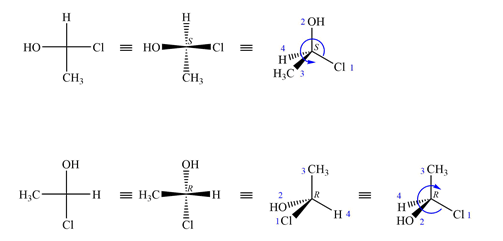
The priority 1 to 3 groups in the first molecule are arranged counterclockwise with the lowest priority H at the back. The configuration at this carbon is then S.
In the second molecule, these groups are arranged counterclockwise; therefore, its configuration is R, opposite that of the first molecule.
Therefore, the two molecules are enantiomers.
Molecules with a single chiral center are enantiomers if their configurations are different.
(d)
Interpretation:
The specific relationship between the pair of molecules shown is to be determined.
Concept introduction:
The intersection of a horizontal and vertical line indicates a carbon atom- typically an asymmetric carbon. The atom at the intersection is a carbon atom. The substituents on the vertical bonds point away from the observer while those on the horizontal bonds point toward the observer.
To determine the R/S configuration at the asymmetric carbon (chiral center), the vertical bonds are replaced by dash bonds and horizontal ones by wedge bonds. The groups on these bonds are then assigned priorities according to Cahn-Ingold-Prelog rules. If the priority groups 1 to 3 are arranged clockwise with the lowest priority group pointing away (at the back), the configuration of the asymmetric carbon is R. If they are arranged counterclockwise, the configuration is S.
If the lowest priority group is pointing toward the observer (it is in the front), then the actual configuration is reverse of that indicated. That means if the arrangement is clockwise, the actual configuration is S, and if counterclockwise, it is R.
If the molecules have different formulas, they are unrelated compounds. If the formulas are same, but the connectivity of atoms is different, the molecules are constitutional isomers.
If the formulas as well as connectivities are the same, then the molecules may be the same or stereoisomers.
The configuration of each asymmetric carbon is then compared to determine the specific relationship between the two molecules. If the configurations are the same, the molecules may be the same or conformers of the same molecule. Conformers are molecules that can be interconverted by a rotation about a single bond.
If the configurations at a single chiral center are different, then the two molecules are enantiomers.
If the molecule contains more than one chiral center, then a difference in the configuration of all chiral centers makes them enantiomers. If the configurations are different at some but not all the chiral centers, then the molecules are diastereomers.
Answer to Problem 5.73P
The two molecules are enantiomers.
Explanation of Solution
The Fischer projections of the molecules are

The molecules can be interconverted by exchanging the positions of two of the four groups,
Therefore these are enantiomer.
Exchanging positions of two of the four groups attached to an asymmetric carbon inverts its configuration.
(e)
Interpretation:
The specific relationship between the pair of molecules shown is to be determined.
Concept introduction:
The intersection of a horizontal and vertical line indicates a carbon atom- typically an asymmetric carbon. The atom at the intersection is a carbon atom. The substituents on the vertical bonds point away from the observer while those on the horizontal bonds point toward the observer.
To determine the R/S configuration at the asymmetric carbon (chiral center), the vertical bonds are replaced by dash bonds and horizontal ones by wedge bonds. The groups on these bonds are then assigned priorities according to Cahn-Ingold-Prelog rules. If the priority groups 1 to 3 are arranged clockwise with the lowest priority group pointing away (at the back), the configuration of the asymmetric carbon is R. If they are arranged counterclockwise, the configuration is S.
If the lowest priority group is pointing toward the observer (it is in the front), then the actual configuration is reverse of that indicated. That means if the arrangement is clockwise, the actual configuration is S, and if counterclockwise, it is R.
If the molecules have different formulas, they are unrelated compounds. If the formulas are same, but the connectivity of atoms is different, the molecules are constitutional isomers.
If the formulas as well as connectivities are the same, then the molecules may be the same or stereoisomers.
The configuration of each asymmetric carbon is then compared to determine the specific relationship between the two molecules. If the configurations are the same, the molecules may be the same or conformers of the same molecule. Conformers are molecules that can be interconverted by a rotation about a single bond.
If the configurations at a single chiral center are different, then the two molecules are enantiomers.
If the molecule contains more than one chiral center, then a difference in the configuration of all chiral centers makes them enantiomers. If the configurations are different at some but not all the chiral centers, then the molecules are diastereomers.
Answer to Problem 5.73P
The two molecules are enantiomers.
Explanation of Solution
The Fischer projections of the two molecules are
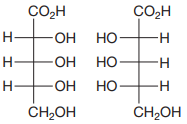
The molecules are aldonic acids with the same molecular formula and connectivity. Each contains three asymmetric carbons, C2, C3, and C4. Therefore, they can be the same molecules, conformers, or configurational isomers.
The two cannot be interconverted by a rotation about a single bond; therefore, they are not conformers.
The configurations of each of these three must be compared to determine the specific relation between the two molecules.
To determine the configurations of the three asymmetric carbons, the Fischer projection is redrawn as a dash-wedge structure at each carbon.

The vertical bonds in the Fischer projection are pointed away from the observer, while the horizontal ones are pointed toward the observer. The four groups attached to the asymmetric carbon are then assigned priorities according to Cahn-Ingold-Prelog rules. Based on the priorities, the configurations at the three asymmetric carbons in the first molecule are
Therefore, the two molecules are enantiomers.
When the configurations at every asymmetric carbon in the pair of molecules with the same formula and connectivity are different, the molecules are enantiomers.
(f)
Interpretation:
The specific relationship between the pair of molecules shown is to be determined.
Concept introduction:
The intersection of a horizontal and vertical line indicates a carbon atom- typically an asymmetric carbon. The atom at the intersection is a carbon atom. The substituents on the vertical bonds point away from the observer while those on the horizontal bonds point toward the observer.
To determine the R/S configuration at the asymmetric carbon (chiral center), the vertical bonds are replaced by dash bonds and horizontal ones by wedge bonds. The groups on these bonds are then assigned priorities according to Cahn-Ingold-Prelog rules. If the priority groups 1 to 3 are arranged clockwise with the lowest priority group pointing away (at the back), the configuration of the asymmetric carbon is R. If they are arranged counterclockwise, the configuration is S.
If the lowest priority group is pointing toward the observer (it is in the front), then the actual configuration is reverse of that indicated. That means if the arrangement is clockwise, the actual configuration is S, and if counterclockwise, it is R.
If the molecules have different formulas, they are unrelated compounds. If the formulas are same, but the connectivity of atoms is different, the molecules are constitutional isomers.
If the formulas as well as connectivities are the same, then the molecules may be the same or stereoisomers.
The configuration of each asymmetric carbon is then compared to determine the specific relationship between the two molecules. If the configurations are the same, the molecules may be the same or conformers of the same molecule. Conformers are molecules that can be interconverted by a rotation about a single bond.
If the configurations at a single chiral center are different, then the two molecules are enantiomers.
If the molecule contains more than one chiral center, then a difference in the configuration of all chiral centers makes them enantiomers. If the configurations are different at some but not all the chiral centers, then the molecules are diastereomers.
Answer to Problem 5.73P
The molecules are diastereomers.
Explanation of Solution
The Fischer projections of the two molecules are
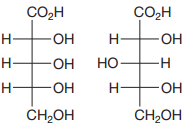
The molecules are aldonic acids with the same molecular formula and connectivity. Each contains three asymmetric carbons, C2, C3, and C4. Therefore, they can be the same molecules, conformers, or configurational isomers.
The two cannot be interconverted by a rotation about a single bond; therefore, they are not conformers.
The configurations of each of these three must be compared to determine the specific relation between the two molecules.
To determine the configurations of the three asymmetric carbons, the Fischer projection is redrawn as a dash-wedge structure at each carbon.

The vertical bonds in the Fischer projection are pointed away from the observer while the horizontal ones are pointed toward the observer. The four groups attached to the asymmetric carbon are then assigned priorities according to Cahn-Ingold-Prelog rules. Based on the priorities, the configurations at the three asymmetric carbons in the first molecule are
Therefore, the two molecules are diastereomers.
Two chiral molecules with multiple chiral centers that differ in configuration at some but not all chiral centers are diastereomers.
Want to see more full solutions like this?
Chapter 5 Solutions
Organic Chemistry: Principles And Mechanisms: Study Guide/solutions Manual (second)
- 0.0994 g of oxalic acid dihydrate is titrated with 10.2 mL of potassium permanganate. Calculate the potassium permanganate concentration. Group of answer choices 0.0433 M 0.135 M 0.0309 M 0.193 Marrow_forwardExperts...can any one help me solve these problems?arrow_forwardAccording to standard reduction potential data in Lecture 4-1, which of the following species is the most difficult to reduce? Group of answer choices Zn2+ AgCl(s) Al3+ Ce4+arrow_forward
- Which Group 1 metal reacts with O2(g) to form a metal peroxide (M2O2)? Group of answer choices Li K Rb Naarrow_forwardWhich of the following statements is true regarding the reaction between Group 1 metals and water? Group of answer choices These reactions result in a basic solution. The metals do not actually react easily with water due to the metals' lack of conductivity. These reaction result in an acidic solution. The metals need their outer coatings of metal oxides to react.arrow_forwardWhich element cannot interact with hydrogen through hydrogen bonds? Group of answer choices O S Br Narrow_forward
- Which of the following statements is false regarding hydrogen gas production? Group of answer choices Steam reforming requires a catalyst. Methanol (CH3OH) can react with water using a ZnO catalyst to form H2(g). Methanol (CH3OH) can react with O2(g) using a Pd catalyst to form H2(g). The reaction between CH4(g) and H2O to form H2(g) requires a temperature of at least 700 oCarrow_forwardWhich of the following forms of hydrogen is the least stable? Group of answer choices H H2 H− H+arrow_forwardConsider the following reduction half reactions and standard reduction potentials: Fe3+ + e− → Fe2+ Eo = +0.77 V Fe2+ + e− → Fe(s) Eo = -0.44 V Which of the following statements is true? Group of answer choices The Fe2+ reduction to Fe(s) is spontaneous. Fe2+ can disproportionate into Fe3+ and Fe(s) The Fe3+ reduction to Fe2+ is not spontaneous. Fe3+ and Fe(s) can undergo a comproportionation reaction to form Fe2+arrow_forward
- According to standard reduction potential data in Lecture 4-1, which of the following species is the most difficult to reduce? Group of answer choices Zn2+ AgCl(s) Al3+ Ce4+arrow_forwardConsider the redox reaction: 2 P4 + 8 OH− + 4 H2O → 4 PH3 + 4 HPO32− The element oxidized is ["", "", ""] , the element reduced is ["", "", ""] , one of the oxidizing agents is ["", "", ""] , and the reducing agent is ["", "", ""] .arrow_forwardWhat is the missing reactant in this organic reaction? OH H + R Δ CH3-CH2-CH-CH3 O CH3 CH3-CH2-C-O-CH-CH2-CH3 + H2O Specifically, in the drawing area below draw the condensed structure of R. If there is more than one reasonable answer, you can draw any one of them. If there is no reasonable answer, check the No answe box under the drawing area. Explanation Check Click anywhere to draw the first atom of your structure. C O2025 McGraw Hill LLC. All Rights Reserved. Terms of Use | Privacy Cerarrow_forward
 Organic Chemistry: A Guided InquiryChemistryISBN:9780618974122Author:Andrei StraumanisPublisher:Cengage Learning
Organic Chemistry: A Guided InquiryChemistryISBN:9780618974122Author:Andrei StraumanisPublisher:Cengage Learning
